| Article ID | Journal | Published Year | Pages | File Type |
|---|---|---|---|---|
| 6552567 | Forensic Science International | 2014 | 55 Pages |
Abstract
Twelve pig carcasses were differentially buried and sub-aerially exposed for one year at Riseholme, Lincolnshire, U.K. Their femora were examined after one year using thin section light microscopy to investigate the patterns of microscopic bioerosion. The distribution and extent of degradation observed within the microstructures of the pig femora were consistent with bacterial bioerosion. The early occurrence of bioerosion within the Riseholme samples suggested that enteric putrefactive bacteria are primarily responsible for characteristic internal bone bioerosion. The distribution of bioerosion amongst the buried/unburied and stillborn/juvenile pig remains also supported an endogenous model. Bone from stillborn neonatal carcasses always demonstrated immaculate histological preservation due to the intrinsic sterility of newborn infant intestinal tracts. Bioerosion within the internal microstructure of mature bone will reflect the extent to which the skeletal element was exposed to putrefaction. Bone histology should be useful in reconstructing early taphonomic events. There is likely to be a relationship between post mortem processes that deny enteric gut bacteria access to internal bone microstructures and the survival of biomolecules.
Related Topics
Physical Sciences and Engineering
Chemistry
Analytical Chemistry
Authors
Lorraine White, Thomas J. Booth,
